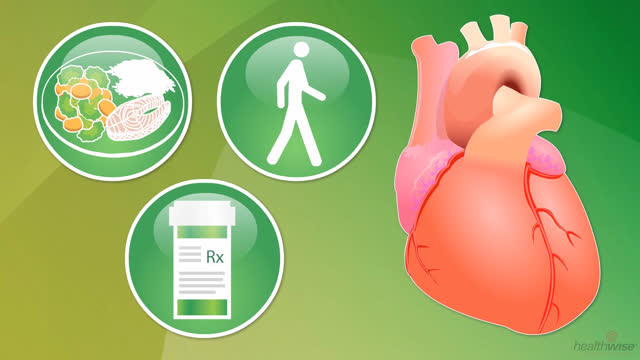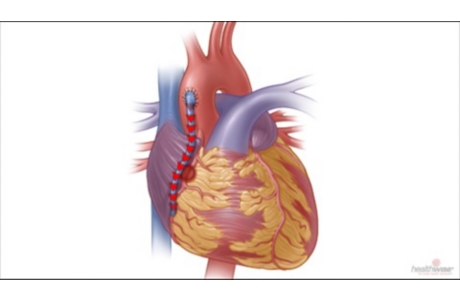Coronary Artery Bypass Graft Surgery: Recovering in the Hospital
Topic Overview
You will recover in the hospital after coronary artery bypass graft (CABG) surgery until your doctors feel it is safe for you to go home. During this time, staff on the cardiac recovery floor will help begin your rehabilitation and educate you on how to care for yourself when you return home. You must demonstrate that you are capable of performing basic daily functions, including walking and sitting upright, before your doctor will agree to release you from the hospital.
Setting goals for your recovery
The staff on the cardiac recovery floor will assist you in achieving the criteria that assure them that you will be safe when you go home. Your family and friends can play important roles in your recovery.
Typical criteria to be released from the hospital include the following:
- You are able to eat adequately.
- You are able to walk 100 ft (30 m) to 150 ft (45 m), four times a day.
- Your pain has been controlled so that it does not interfere with your physical activities.
Breathing
When you arrive on the cardiac recovery floor, you will have a small tube just below your nose that supplies oxygen to your lungs. Although it may be painful, it is important that you try to take deep breaths. Taking deep breaths is the only way to use your lungs to full capacity. If you fail to take periodic deep breaths, you are more likely to develop pneumonia.
Flexing your chest wall muscles
You will exercise your chest wall muscles during your recovery with a machine called an incentive spirometer. This machine requires you to inhale forcefully through a tube connected to an air column containing a ball or a similar device. As you breathe inward, the ball within the air column moves up. How high the ball moves up shows how much air you inhale.
A healthy person who has not had surgery can typically inhale forcefully through the spirometer until the ball reaches the very top of the air column. But when you first arrive on the cardiac recovery floor, your lung capacity may only push the ball halfway up the column. By the end of your hospital stay, you should regain your full lung capacity. As you use the spirometer, your nurse or respiratory therapist will also work to improve your breathing function by asking you to breathe deeply and cough. This action keeps your lungs moving and increases their capacity.
Eliminating extra fluid weight
Most people who undergo CABG surgery retain large amounts of fluid after surgery. The majority of this fluid is usually water. Your nurses will make sure that you are getting rid of the extra fluid by:
- Carefully monitoring your fluid intake and output.
- Restricting the amount of salt in your diet.
- Giving you medicines (diuretics) that help your kidneys remove extra water from your body.
Eating
Before you can leave the hospital, you must be able to eat and digest your meals. Although at first you may not be hungry enough to eat much food, you will need to get all the energy that the food provides as you become more active in the days following your CABG surgery. When you return home, eat a heart-healthy diet. If you have not been eating this way, talk to your doctor. You also may want to talk to a dietitian. A dietitian can help you learn about healthy foods.
Anesthesia and appetite
Along with putting you to sleep during surgery, anesthesia has several side effects. Two of the most unpleasant side effects are nausea and constipation. While nausea will soon wear off, your constipation can leave you uncomfortable for several days after your surgery. Your nurses can give you a medicine to promote bowel movement. However, eating may actually be the most effective means of ending constipation, because food will push waste through your system.
Sitting
You should also be able to sit up in a chair for at least an hour by the time you leave the hospital. Sitting up is a good way to expand your lungs and help them reach full capacity. Sitting also helps:
- Increase strength.
- Improve blood circulation.
- Alleviate constipation.
- Prevent pneumonia.
- Prevent blood clots in your legs.
Walking
You should try to walk about100 ft (30 m) four times a day. This usually means a trip around the hallway of the cardiac recovery floor. You may need help at first. Walking is especially important because it shows that you are physically able to get around after you leave the hospital. Walking also helps:
- Expand lung capacity.
- Increase strength.
- Improve blood circulation.
- Alleviate constipation.
- Prevent pneumonia.
- Prevent blood clots in your legs.
Ready or not?
You may meet most of the criteria to go home but may not be able to do certain things well enough to go home. In this case, you may go to a type of assisted-living facility instead of to your home. Nurses and rehabilitation specialists at an assisted-living facility can help you work toward getting home.
Support during your recovery
During recovery, the hospital staff can help you a great deal. You will need to move around despite your incisions and to breathe deeply despite chest pain.
Medical teams that will help you with your recovery
- Doctors: Your doctors (including your cardiac surgeon, cardiologist, and various specialists) will check on your daily progress, examine you, prescribe and adjust your medicines, and treat any complications.
- Nursing team: Your nurses will help make sure that you take your medicines, assist you with moving around and getting to the bathroom, and monitor your blood pressure, temperature, and pulse. They are also in the hospital ward around the clock and can help you if you have any medical or other concerns.
- Other medical team members who might be part of a cardiac rehabilitation program include respiratory therapists, occupational therapists, physical therapists, and registered dietitians.
- Additional hospital staff support: While doctors and nurses help to ensure that you are recovering from your CABG surgery, other hospital staff can assist you in other ways. For example, they can help you organize your belongings, answer questions about your recovery, and direct you to helpful medical resources. Working with these staff members may help you reach your recovery goals. Hospital staff members who may visit you during your hospital stay include:
- A social worker, who makes sure that you go home with any help or nursing that you may need.
- Your case manager, who interacts with your insurance company and can help you extend your insurance coverage for additional recovery days or rehabilitation needs.
Going home
As you prepare to leave the hospital, your medical team will give you many instructions about how to care for yourself. You may want to have a folder or binder to keep this information organized. Many of the hospital staff members who have helped you recover during your hospital stay may not be available when you are at home. So it is very important that you pay close attention to all the instructions that they give you.
Your hospital stay is only the beginning of your recovery from CABG surgery. In the weeks that follow, you will continue to heal and get stronger. Be sure to follow your doctor’s instructions to care for yourself.
After you go home, be sure to go to your cardiac rehab appointments. If you are not in a program, ask your doctor about whether rehab is right for you.
Current as of: April 9, 2019
Author: Healthwise Staff
Medical Review:Rakesh K. Pai, MD – Cardiology, Electrophysiology & E. Gregory Thompson, MD – Internal Medicine & Martin J. Gabica, MD – Family Medicine & Adam Husney, MD – Family Medicine & David C. Stuesse, MD – Cardiac and Thoracic Surgery
This information does not replace the advice of a doctor. Healthwise, Incorporated, disclaims any warranty or liability for your use of this information. Your use of this information means that you agree to the Terms of Use. Learn how we develop our content.






